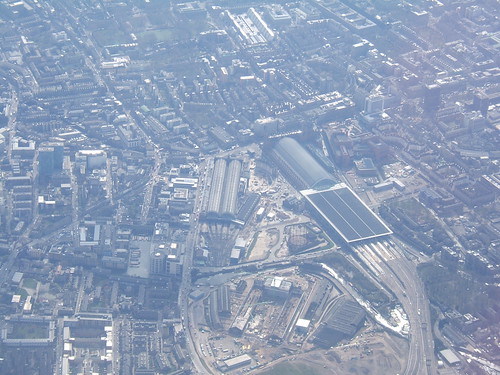
Aerial view taken in 2009 showing the twin train sheds of King's Cross (centre) and Barlow's train shed at St. Pancras International the with modern flat-roofed northern extension (right).
King's Cross station in London was opened in 1852 as the southern terminus of the Great Northern Railway. Twin trainsheds by Lewis Cubitt covered just two platforms (one arrival, one departure) separated by a number of sidings for storing passenger carriages. Growth in traffic resulted in a number of additional platforms being constructed within the twin trainshed. In 1875 a separate suburban station was added on the west side (now platforms 9,10 and 11) and, in 1878, underground connections allowed local trains from the north to pass directly onto the Metropolitan Railway. In 1923, King's Cross became part of the London and North Eastern Railway (LNER), becoming famous for the 'crack' East Coast Main Line expresses including the 'Flying Scotsman' service. In 1948, nationalisation of railways in Britain ushered in a more chequered period.
My first brief visit was when I was nine. I was most impressed by the hustle and bustle of a large terminus and by the Gresley 'Pacifics'. Over the years since, I've passed through or visited King's Cross station many times.
In 1974, my firm received an order for electrification telephone equipment for the Great Northern Electrification Project, covering 100 route-kilometres from King's Cross to Hitchin, via both the main line and the Hertford Loop, with an Electrical Control Room at Hornsey, about four miles north of King's Cross, London. For this project, we supplied telephones with mounting plates plus repeaters, terminal racks and a Cord Switchboard. We also took responsibility for installation and commissioning, including the lineside telephones. Handling all aspects of installation gave a new dimension to this project. That project is briefly mentioned in the post Electrification Telephone Systems for British Rail but I'll add more when I can.
In 2006, my firm started work on equipment for renewal of the Tunnel Telephone system on the Northern City Line from Moorgate to Finsbury Park (controlled from King's Cross Power Signal Box). The Northern City Line (and our equipment) is described in the post Northern City Line.
A visit to King's Cross in February 2008 in connection with that renewal work resulted in the post London's Terminal Stations which discussed King's Cross, St. Pancras and Euston. During that visit, I'd admired the old footbridge at King's Cross, halfway along the trainsheds, with its dual clockfaces.
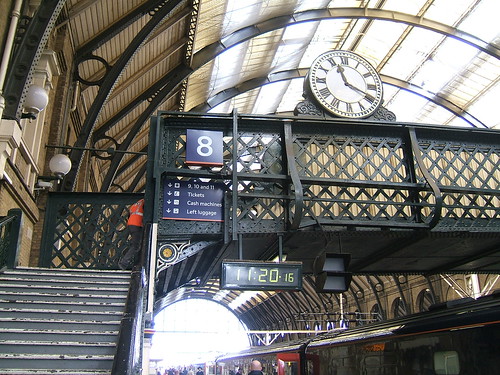
King's Cross: View of station footbridge showing one clockface from platform level. In the background, the horizontal drive shaft linking both clockfaces back to the mechanism in the office building can be seen.
Sadly, on my return in October 2009, I'm afraid the footbridge was being demolished as part of a major redevelopment at King's Cross. There's a post about the redevelopment here.

King's Cross: View of station footbridge being demolished.
Despite electrification, two of the four long-distance trains pictured below in 2009 remained diesel-powered!
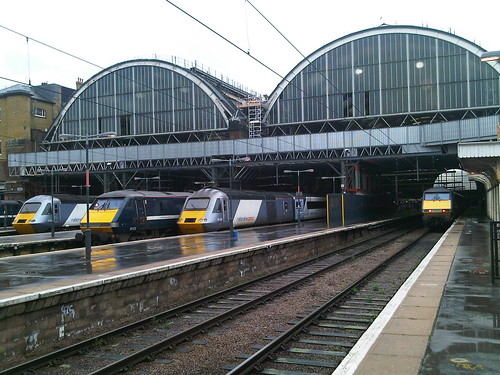
King's Cross Station in 2009.
At the end of 2009, I ran a couple of technical training courses at King's Cross covering maintenance of our Tunnel Telephone system. The first of these was in the famous East Side Offices.
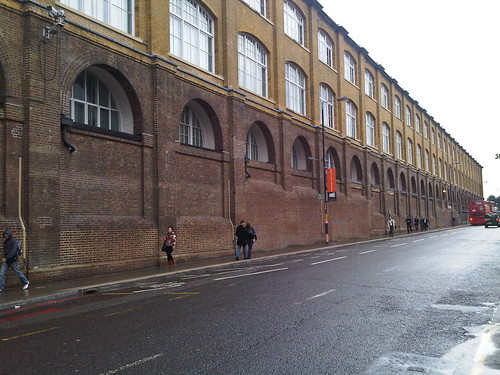
King's Cross Station East side offices viewed from York Way in 2009.
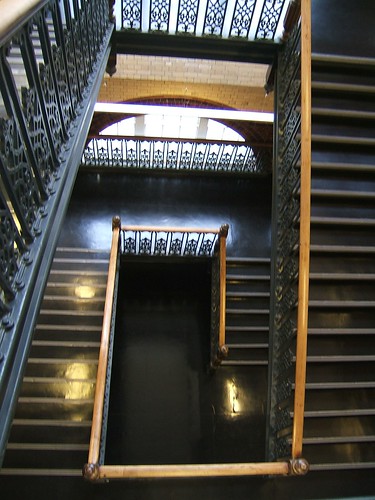
The rather grand stairs halfway along the East Side Offices building.
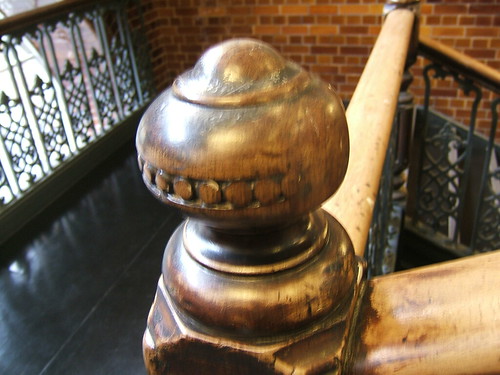
Imagine the generations of Railway Officers who have worn away the carved newel cap.
The second training course was held within King's Cross Power Signal Box. Since the training room had a panoramic view of King's Cross station throat and the track remodelling in progress, I had some difficulty keeping my attention on the business in hand.
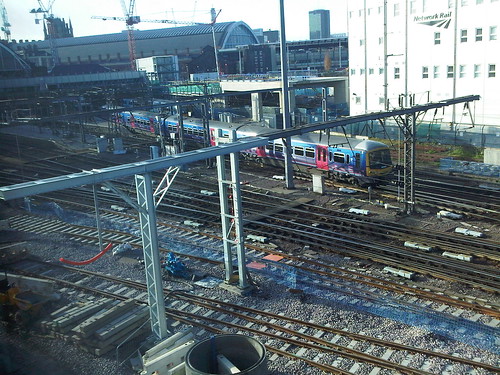
King's Cross station throat, viewed from the Power Signal Box.
Part of the remodelling involved an additional platform on the East Side, actually underneath the East Side offices. In the post about the redevelopment mentioned above, I reported that I'd been assured that the extra platform would not be '0' for technical reasons, but when I visited on 15th September 2010 I found that King's Cross now shared the rare distinction of possessing a Platform 0 (rendering my earlier post Platform Numbering Revisited out-of-date).
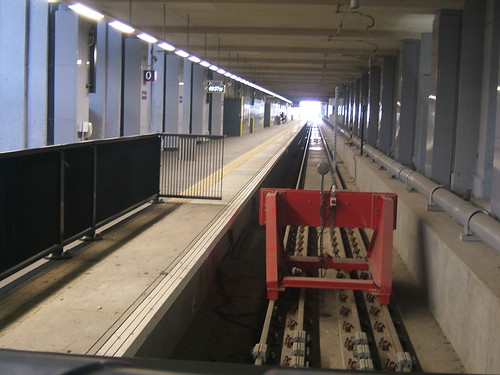 King's Cross Station: Platform 0 looking north.
King's Cross Station: Platform 0 looking north.
Whilst on the topic of unusual platform numbers, in 2008 I'd been surprised to discover that, to satisfy Harry Potter fans, there was an opportunity to take a photograph of a luggage trolley disappearing through the wall leading to Platform 9-3/4!
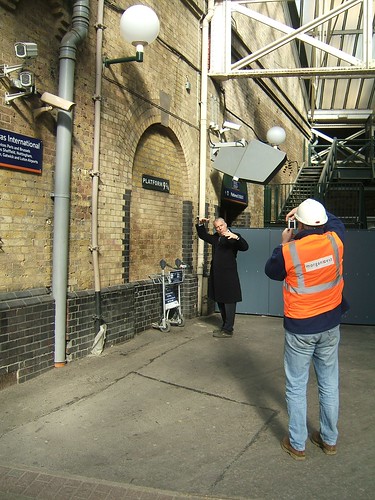
A contractor takes a picture of a visitor at the entrance to platform 9-3/4 on 26-Feb-2008.
Returning in 2009 I was even more surprised to discover that the entrance had magically moved.

A visitor at the entrance to platform 9-3/4 on 21-Oct-2009 - location magically moved!
In June 2013, I first examined the now-completed redevelopment. In general, I approve of the treatment of the original buildings, although I'm not a fan of John McAslan's soaring concourse area (particularly when the supporting steel work is bathed in a rather lurid purple light).

King's Cross Station: The New Concourse illuminated in 2017.
But I applaud the restoration of the original appearance of Lewis Cubitt's 1852 train shed.
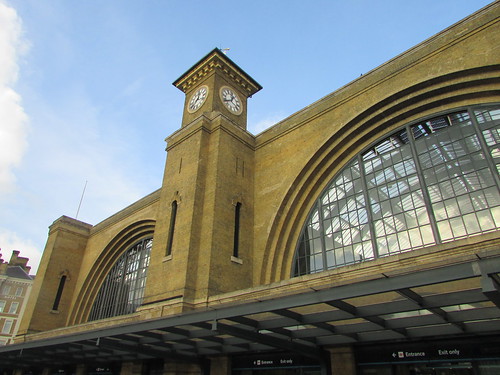
King's Cross Station: The simple but elegant end of the train shed is once-again revealed.
Related posts on other websites
London King's Cross railway station (Wikipedia)
Related posts on this website
Electrification Telephone Systems for British Rail (mentions Great Northern Suburban Electrification).
London's Terminal Stations (discusses King's Cross).
Northern City Line.
Redevelopment at King's Cross Station.
Class 373 Test Train to Grantham.
Rail Research UK Association Annual Conference 2017.
My Pictures
Where necessary, clicking on an image above will display an 'uncropped' view or, alternately, pictures from may be selected, viewed or downloaded, in various sizes, from the album listed:-
London: King's Cross Station.
